This article needs additional citations for verification .(July 2016) |
The following works of fiction are based in the 14th century:
This article needs additional citations for verification .(July 2016) |
The following works of fiction are based in the 14th century:
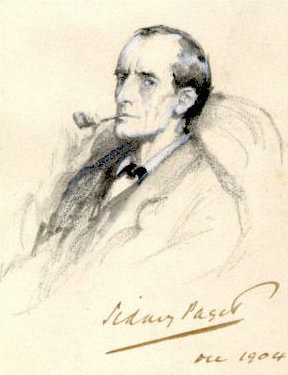
Sherlock Holmes is a fictional detective created by British author Arthur Conan Doyle. Referring to himself as a "consulting detective" in his stories, Holmes is known for his proficiency with observation, deduction, forensic science and logical reasoning that borders on the fantastic, which he employs when investigating cases for a wide variety of clients, including Scotland Yard.
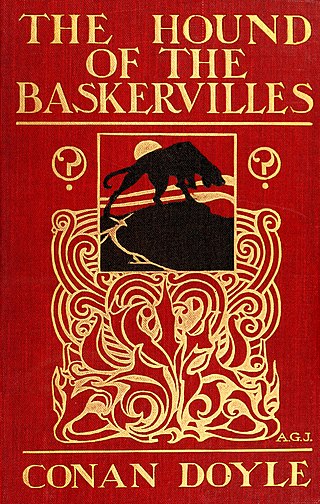
The Hound of the Baskervilles is the third of the four crime novels by British writer Arthur Conan Doyle featuring the detective Sherlock Holmes. Originally serialised in The Strand Magazine from August 1901 to April 1902, it is set largely in Dartmoor, Devon, in England's West Country and follows Holmes and Watson investigating the legend of a fearsome, diabolical hound of supernatural origin. This was the first appearance of Holmes since his apparent death in "The Final Problem", and the success of The Hound of the Baskervilles led to the character's eventual revival.
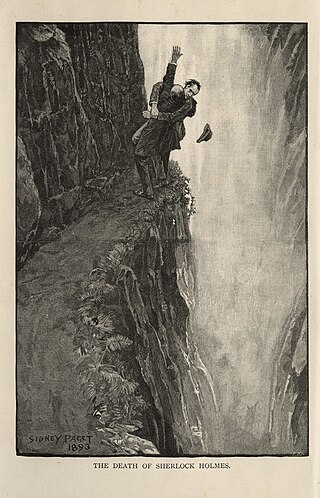
"The Final Problem" is a short story by Sir Arthur Conan Doyle featuring his detective character Sherlock Holmes. It was first published in The Strand Magazine in the United Kingdom, and McClure's in the United States, under the title "The Adventure of the Final Problem" in December 1893. It appears in book form as part of the collection The Memoirs of Sherlock Holmes.

"The Five Orange Pips", one of the 56 Sherlock Holmes short stories written by Sir Arthur Conan Doyle, is the fifth of the twelve stories in The Adventures of Sherlock Holmes.

The Valley of Fear is the fourth and final Sherlock Holmes novel by British writer Arthur Conan Doyle. It is loosely based on the Molly Maguires and Pinkerton agent James McParland. The story was first published in the Strand Magazine between September 1914 and May 1915. The first book edition was copyrighted in 1914, and it was first published by George H. Doran Company in New York on 27 February 1915, and illustrated by Arthur I. Keller.

Detective Inspector G. Lestrade, or Mr. Lestrade, is a fictional character appearing in several of the Sherlock Holmes stories written by Arthur Conan Doyle. Lestrade's first appearance was in the first Sherlock Holmes story, the novel A Study in Scarlet, which was published in 1887. The last story in which he appears is the short story "The Adventure of the Three Garridebs", which was first published in 1924 and was included in the final collection of Sherlock Holmes stories by Doyle, The Case-Book of Sherlock Holmes.
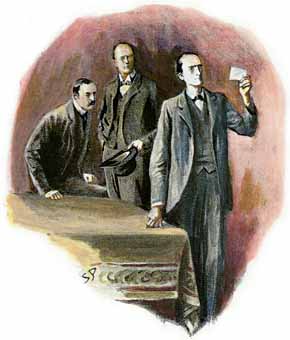
The Adventure of the Dancing Men is a Sherlock Holmes story written by Sir Arthur Conan Doyle as one of 13 stories in the cycle published as The Return of Sherlock Holmes in 1905. It was first published in The Strand Magazine in the United Kingdom in December 1903, and in Collier's in the United States on 5 December 1903.

The White Company is a historical adventure by British writer Arthur Conan Doyle, set during the Hundred Years' War. The story is set in England, France and Spain, in the years 1366 and 1367, against the background of the campaign of Edward the Black Prince, to restore Peter of Castile to the throne of the Kingdom of Castile. The climax of the book occurs before the Battle of Nájera. Doyle became inspired to write the novel after attending a lecture on the Middle Ages in 1889. After extensive research, The White Company was published in serialised form in 1891 in The Cornhill Magazine. Additionally, the book is considered a companion to Doyle's 1905–06 Sir Nigel, which explores the early campaigns of Sir Nigel Loring and Samkin Aylward.
The lost world is a subgenre of the fantasy or science fiction genres that involves the discovery of an unknown Earth civilization. It began as a subgenre of the late-Victorian adventure romance and remains popular into the 21st century.

The Adventures of Sherlock Holmes is a 1939 American mystery adventure film based on Sir Arthur Conan Doyle's Sherlock Holmes detective stories. Although claiming to be an adaptation of the 1899 play Sherlock Holmes by William Gillette, the film bears little resemblance to the play.
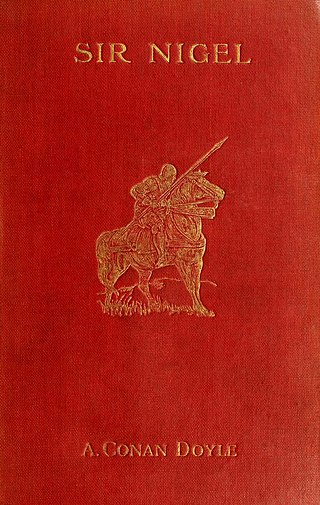
Sir Nigel is a historical novel set during the early phase of the Hundred Years' War, spanning the years 1350 to 1356. It was written by British author Sir Arthur Conan Doyle, first published in serial form during 1905–06 where it was illustrated by Joseph Clement Coll. It was illustrated by The Kinneys and Arthur Twidle in its book editions. It is the background story to Doyle's earlier novel The White Company (1891), and describes the early life of that book's hero, Nigel Loring, a knight in the service of King Edward III in the first phase of the Hundred Years' War. The character is loosely based on the historical knight Neil Loring.

Traditionally, the canon of Sherlock Holmes consists of the 56 short stories and four novels written by Sir Arthur Conan Doyle. In this context, the term "canon" is an attempt to distinguish between Doyle's original works and subsequent works by other authors using the same characters. Usually capitalized by aficionados of the Sherlockian game as "the Canon", the description of these 60 adventures as the Sherlock Holmes canon and the game of applying the methods of "Higher Criticism" to it was started by Ronald Knox as a playful use of the traditional definition of canon as an authoritative list of books accepted as holy scripture.

Sir Arthur Ignatius Conan Doyle was a British writer and physician. He created the character Sherlock Holmes in 1887 for A Study in Scarlet, the first of four novels and fifty-six short stories about Holmes and Dr. Watson. The Sherlock Holmes stories are milestones in the field of crime fiction.

"Lot No. 249" is a Gothic horror short story by British writer Arthur Conan Doyle, first published in Harper's Magazine in 1892. The story tells of a University of Oxford athlete named Abercrombie Smith who notices a strange series of events surrounding Edward Bellingham, an Egyptology student who owns many ancient Egyptian artefacts, including a mummy. After seeing his mummy disappear and reappear, and two instances of Bellingham's enemies being attacked, Smith concludes that Bellingham is re-animating his mummy.

Sir Arthur Conan Doyle KStJ, DL (1859–1930) was a Scottish writer and physician. In addition to the series of stories chronicling the activities of Sherlock Holmes and his friend Dr John Watson for which he is well known, Doyle wrote on a wide range of topics, both fictional and non-fictional. In 1876 Doyle entered the University of Edinburgh Medical School, where he became a pupil of Joseph Bell, whose deductive processes impressed his pupil so much that the teacher became the chief model for Holmes. Doyle began writing while still a student, and in October 1879 he had his first work—"The Mystery of the Sasassa Valley"—published in Chambers's Journal. He continued writing short works—both fictional and non-fictional—throughout his career, and had over 200 stories and articles published.

Undershaw is a former residence of the author Sir Arthur Conan Doyle, the creator of Sherlock Holmes. The house was built for Doyle at his order to accommodate his wife's health requirements, and is where he lived with his family from 1897 to 1907. Undershaw is where Doyle wrote many of his works, including The Hound of the Baskervilles.

Sir Neil Loring, KG (also "Neel", "Nele", "Nigel", "Loryng", "Loringe"; Latin: Nigellus; was a medieval English soldier and diplomat and a founding member of the Order of the Garter, established by King Edward III in 1348. The central character in two historical novels by Sir Arthur Conan Doyle, Sir Nigel and The White Company, is loosely based on Neil Loring.

Arthur J. Raffles is a fictional character created in 1898 by E. W. Hornung, brother-in-law of Sir Arthur Conan Doyle, the creator of Sherlock Holmes. Raffles is, in many ways, an inversion of Holmes – he is a "gentleman thief", living at the Albany, a prestigious address in London, playing cricket as a gentleman for the Gentlemen of England and supporting himself by carrying out ingenious burglaries. He is called the "Amateur Cracksman" and often, at first, differentiates between him and the "professors" – professional criminals from the lower classes.

Douglas Kerr is a British writer and academic who is best known for his work on Arthur Conan Doyle and George Orwell.
The Edwardians is a television miniseries or anthology series which was produced by the BBC, and first aired on BBC Television in 1972–73. In the United States, the series aired on PBS's Masterpiece Theatre in 1974. Consisting of eight 90 minute episodes, each episode examines a different individual of historical importance from the Edwardian era with one episode being devoted to Henry Royce and Charles Rolls. The figures who have a single episode devoted to each are Horatio Bottomley; E. Nesbit; Sir Arthur Conan Doyle; Robert Baden-Powell; Marie Lloyd; Daisy Greville, Countess of Warwick; and David Lloyd George.